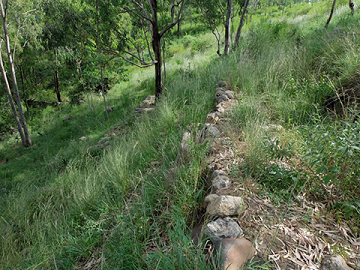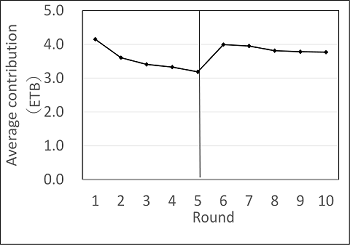Providing information on collaborative behaviors is important for communal forest management in Ethiopia
Description
Many forests in northern Ethiopian highlands are communal forests managed by local farmers. These farmers collectively adopt soil and water conservation practices, such as construction of stone bunds and excavation of deep trenches, to maintain forests and supervise reforestation (Fig. 1). All members of a rural community are supposed to engage in the conservation without cash payment, in exchange for them being able to collect animal fodder and firewood. However, there are concerns over the longevity of the collaboration.The sustainability of communal forests depends on whether or not local people are aware of the importance of collaboration in conservation activities. This study investigates whether providing information regarding the importance of collaboration in conservation work using an economic experiment approach enhances farmers’ cooperative behavior in Ethiopia.
We conducted an economic experiment called the “public goods game” for participants randomly selected from eleven villages in Tigray Region, Ethiopia. Each session involved ten rounds of the game. The procedure of the experiment followed the standard public goods game. Each participant was asked to contribute any amount worth up to 5 ETB (Ethiopian Birr) for communal forest conservation. During the initial instruction, we explained the rules of the experiment and consequences of the investment. Also, just after the 5th round of each game, we repeated the instruction, same as that offered before starting the game. The result shows that while the average contribution continues to decline until the 5th round, it jumps up at the 6th round to almost the same level as the 1st round (Fig. 2). The speed of the decline after the 6th round is slower than that before the 5th round (Table 1). These results suggest that repeating the instruction has a positive impact on local people’s collaboration. Moreover, we have found heterogeneity in the contribution in terms of social and household characteristics (Table 2). Also, the contribution is higher if other members contribute a larger amount in the previous round (Table 2). This demonstrates endogeneity in voluntary contributions.
The results of this study suggest that conducting periodic seminars to remind local farmers of the benefits of communal land could enable them to maintain a high level of commitment to natural resource conservation and sustainable development. It should be noted, however, that farmers’ collaboration for natural resource management may vary among countries, ethnic groups, and geographic characteristics.
Figure, table
-
Fig. 1. A soil and water conservation structure for reforestation built through farmers’ community work
-
Fig. 2. Average contribution by round
The vertical line indicates the timing of intervention.
-
Table 1. Changes in average contribution from Rounds 1 to 5, 5 to 6, and 6 to 10 (ETB)
Period Round 1 to 5 Round 5 to 6 Round 6 to 10 Change in contribution –0.963*** 0.808*** –0.224*** Difference from Round 1-5 - 1.771*** 0.739*** Note: Average of all participants. ***p<0.01.
-
Table 2. Determinants of contribution in the public goods game: Tobit regression model
Variable Coefficient estimate Variable Coefficient estimate Contribution of other members 1.084*** Distance from town 0.021*** Female –0.09 Trust among villagers 0.395*** Education 0.014 Farmland area –0.112** Age 0.206*** Animal holding –0.008 Soil fertility –0.213*** Note: Contribution of other members: the average value of the contribution in the previous round for all of the other participants (ETB: Ethiopian Birr). Female: female participant. Education: a length of formal education (years). Age: Age of participant. Soil fertility: the dummy variable for soil type (0 if Calcisols is dominant and 1 otherwise). Distance from town: distance from a district center to home (km). Trust among villagers: dummy variable to indicate whether villagers trust each other or not. Farmland area: size of participants’ farmland area (ha). Animal holding: the number of livestock in the tropical livestock unit. ***p<0.01, **p<0.05.
- Affiliation
-
Japan International Research Center for Agricultural Sciences Social Sciences Division
- Classification
-
Research
- Research project
- Program name
- Term of research
-
FY2020(FY2016~FY2020)
- Responsible researcher
-
Etsay Haftu ( Mekelle University )
Berhe Melaku ( Mekelle University )
Negash Teklay ( Mekelle University )
Oniki Shunji ( Social Sciences Division )
- ほか
- Publication, etc.
-
https://doi.org/10.3390/su12219290
Oniki S et al. (2020) Sustainability 12:9290
- Japanese PDF
-
2020_A06_A4_ja.pdf358.3 KB
2020_A06_A3_ja.pdf358.38 KB
- English PDF
-
2020_A06_A4_en.pdf375.72 KB
2020_A06_A3_en.pdf377.55 KB
- Poster PDF
-
2020_A06_poster.pdf368.52 KB
* Affiliation at the time of implementation of the study.


